Inton EN
From eqqon
What is Inton?
Due to its revolutionary design, Inton is both a full fledged public address system and a distributed DSP matrix, most notable for its comparably small form factor (allowing it to be DIN-rail mounted), excellent audio quality, ultra-low latency, small energy footprint and perfect scalability.
Inton = network audio matrix + public address system
Inton is a networkable 64-channel mixing matrix. The audio is transmitted between the modules in uncompressed form (at 24bit/48kHz) with a latency of only 0,1ms. Combined with a highly modular design, cost-saving DIN-rail or wall mounting and alle the functionality, that you expect a public address system to have, Inton is the perfect match for a huge amount of use cases.
We designed Inton to be an EN54-16 compliant PA-system, but we have not certified the product yet. Until such time as we do, there are still a lot of use cases for it where the EN54-16 certification is not required, like for instance above-ground train stations, tunnels, airports etc.
An Inton installation consists of many little audio modules that usually connected via CAT5-cables. Every audio module can be optionally equipped with a powerful DSP processor module which makes this sound system an incredibly powerful distributed DSP matrix (if you require that processing power) while being quite affordable (if you don't need it). Simple signal processing functionality like volume control and mixing is already supported out of the box without DSP modules.
System concept
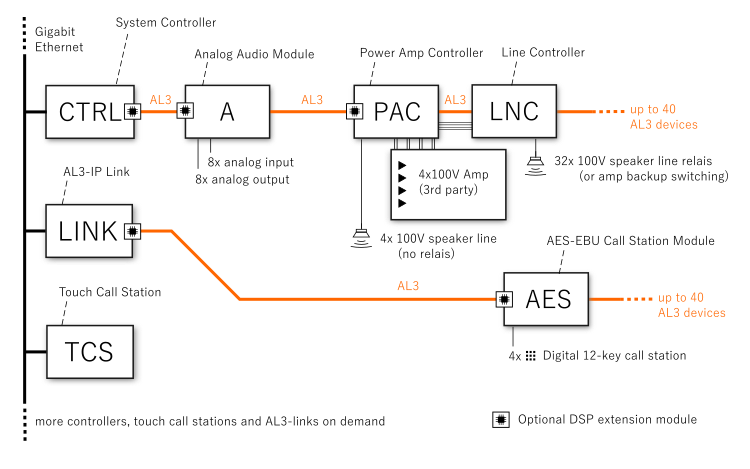
CTRL: The system controller is the central control unit of the Inton system and is connected to other parts of the system installation via IP-network. In most use cases only one or two controllers are needed per installation. It supports one AL3-line that can drive 40 audio modules. If you need more than 64 audio channels you can add as many controllers to the installation as you need.
LINK: The AL3-IP-Link connects an AL3-chain with the IP-network. It allows to add 40 more audio modules to the installation. You can have as many Link devices as you need to add as many audio modules you require.
TCS: Touch-Call-Station is a call station console with a touch display, that is connected to the system via IP-network.
AL3: Al3 stands for "Low-Latency-Audio-Link". It is a fast audio connection with a bandwidth of 64 channels of uncompressed audio (24bit/48kHz) with a maximum latency of 0,1ms over the whole Al3-chain. In additio to audio transport, there are also control signals transmitted over Al3.
A: The analog audio module features eight analog audio inputs and outputs. It is one of the modules that are chainable via AL3 and allows you to add as many analog inputs and outputs to the installation as you need.
PAC: The power amplifier controller allows you to integrate a four-channel 100V-amplifier into the installation and monitors it. The PAC is chainable via AL3 which gives you the power to add as many amp channels to the system as you like. Note: the four 100V-outputs of the PAC do not have a line relais.
LNC: The line relais controller is able to split four 100V channels onto 32 line-relais. It also supports to do hot replacement of failing amplifier channels at several different degrees of redundancy (1:4, 1:8, 1:16, 1:32).
AES: The AES-EBU module allows you to connect up to four AES-EBU call stations into the system. The AES module is chainable via AL3 practically allowing you to add all the call stations you need to the installation.
Efficient cabling with the new AL3 bus
Inton ist highly modular and still very simple to install. The innovative high-speed audio bus AL3 allows to use standard network cables to interconnect between system modules in a "daisy chain fashion". If you wonder how AL3 differs from other popular audio distribution network solutions like Dante, you should note that AL3 does not require costly network switches and no IP-addresses. This means you can have a lot of modules without having to worry about IP addresses and if that weren't already cool enough the modules on the AL3-bus are self organizing. It means that it does not matter at all in what order the components are chained, they will always work just like they were configured to. This is very important if you want to be able to to hot exchange of faulty components while keeping the rest of the network live.

The cost effective and simple cabling is what really empowers the highly modular system design. In turn, the fine grained modularisation has a positive effect on the installation cost because there is always just the right amount of inputs and outputs, call stations and amplifier channels.
AL3 can span up to 100m between modules using CAT5-cable (resulting in a max. AL3-chain length of 4km). If you use media converters and fiberglass cable the distance between two AL3 modules can be multiple kilometres which makes the AL3-bus very attractive for tunnels, train lines and other geographically widely spread installations.

Note that the AL3-bus is particularly well suited for tunnel installations, where you usually have amplifiers that are installed at constant distances throughout the tunnel which have to send audio with an individual delay on each channel, that is entirely depending on the position of the speaker in the tunnel, in order to avoid acoustic interferences like audio cancellation.
Even if you go to the maximum number of modules per bus, AL3 guarantees sample-synchronous audio accross all these modules. The delay between the two ends of the chain is always below 0,1 milliseconds, which is significantly below what human hearing can differentiate.
Small form factor, easy mounting
The Inton modules are so small and lightweight that it they can be mounted on a DIN-rail which is the most widely used standard mounting scheme for electrical installations. In contrast to 19"-rack mounting which is still predominant in audio installations, DIN-rail mounting helps reduce installation cost significantly. Furthermore the small form factor and the possibility of distributed installation can make a huge impact in existing or historic buildings where room for installation is often very scarce.

Decentralized installation
Inton uses standard Ethernet cable (i.e. CAT5) for connecting its components. This allows a decentralized system installation where one or many components are broken out via AL3 or LAN/WAN.
Since AL3 is IP layer 1 it must not be routed over conventional switches. This means that the AL3-chains can not share the same cable installation as the rest of the IT. This can be a blessing because the IT can not influence the audio installation and vice verca. But sometimes it is not feasible to pull in extra cables for AL3, so we provide an alternative way of decentralized installation that makes use of existing IT cabling: Wherever the audio has to be routed over a conventional IP network with routers and switches you can convert AL3 via the AL3-IP-Link modules to an IP audio stream. Of course the ultra-low latency can not be kept up over switches and routers.
Break out modules over AL3 if pulling a separate cable is easily possible or if there is no existing IP-infrastructure. The advantage of AL3 is that you don't need any switches at all.
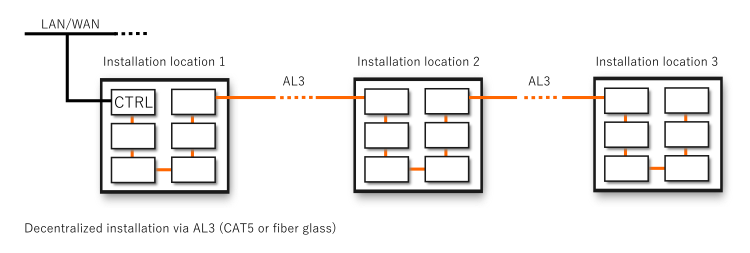
To break out modules over IP-network (LAN / WAN) makes sense, if the network should be shared with IT components or if it would not be economically feasible to pull separate cables for the audio.
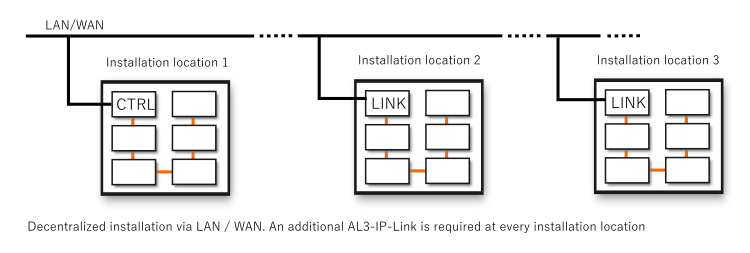
Energy efficiency
Inton is designed to be energy efficient. Saving energy is not only good for the planet, it also reduces costs for cooling (rack climatization) as well as for emergency power supply batteries. The latter are not to be underestimated as a significant cost driver of a public address installation, which has to guarantee up to 72 hours of standby after a power outage.
In case of a power outage a small Inton installation consisting of a controller, an AL3-Link a PAC and a 4-channel amplifier can run in standby mode for 144 hours with only two standard 12V car batteries. If running in normal operation mode the same installation would still last 72 hours with the same batteries.

In other words, with Inton two standard car batteries (connected in series to provide 24V) can power an installation size of 12 speaker lines for 72 hours in standby mode.

The larger the installation, the more batteries have to be included. They need space, have to be maintained and eventually replaced after some time. That is why a highly energy efficient public address system saves you money not only with initial installation cost but also over the whole lifetime of the building.
Fine-grained modularity equals excellent scalability
Thanks to its high degree of modularization, the Inton system scales very well for both small as well has big installations. This means that you get just the right amount of inputs and outputs simply by adding AL3-modules accordingly. By adding a many AL3-Links which each support 40 modules you can create installations with a huge amount of amplifier channels, call stations, analog inputs and outputs etc.
This kind of scalability can be an enormous cost advantage against other less modularized systems, which for instance require another system controller for every four amplifier channels you want to add or even worse, a new controller for every four call stations you want to add. With Inton you never need to buy extra hardware you don't need just to get the right amount of lines, call stations or inputs/outputs.

The system illustrated above already is huge, but it is not even close to the limits of system size. To add another 40 modules of any kind to the installation just add another Al3-Link. So much for scaling up, but Inton also scales down quite good:

By the way, what makes Inton scale even better is the fact that every audio module can be equipped with an optional DSP module that provides extra signal processing power to that module. That way you can build an extremely powerfull distributed network matrix.
Planning and configuring Inton
Inton comes with a well designed configuration software called "Inton Configurator". It allows you to set up your project with a couple of mouse clicks. When you are done planning your system you are also almost done configuring and also as a by-product you get a completely auto-generated project documentation including block diagrams for the installation. Even the graphical UI of the touch call stations can be created and configured in Configurator. When commissioning the installation Configurator loads the configuration into the installed modules. Furthermore, the configuration software contains lots of additional features for maintenance, trouble shooting and system monitoring.
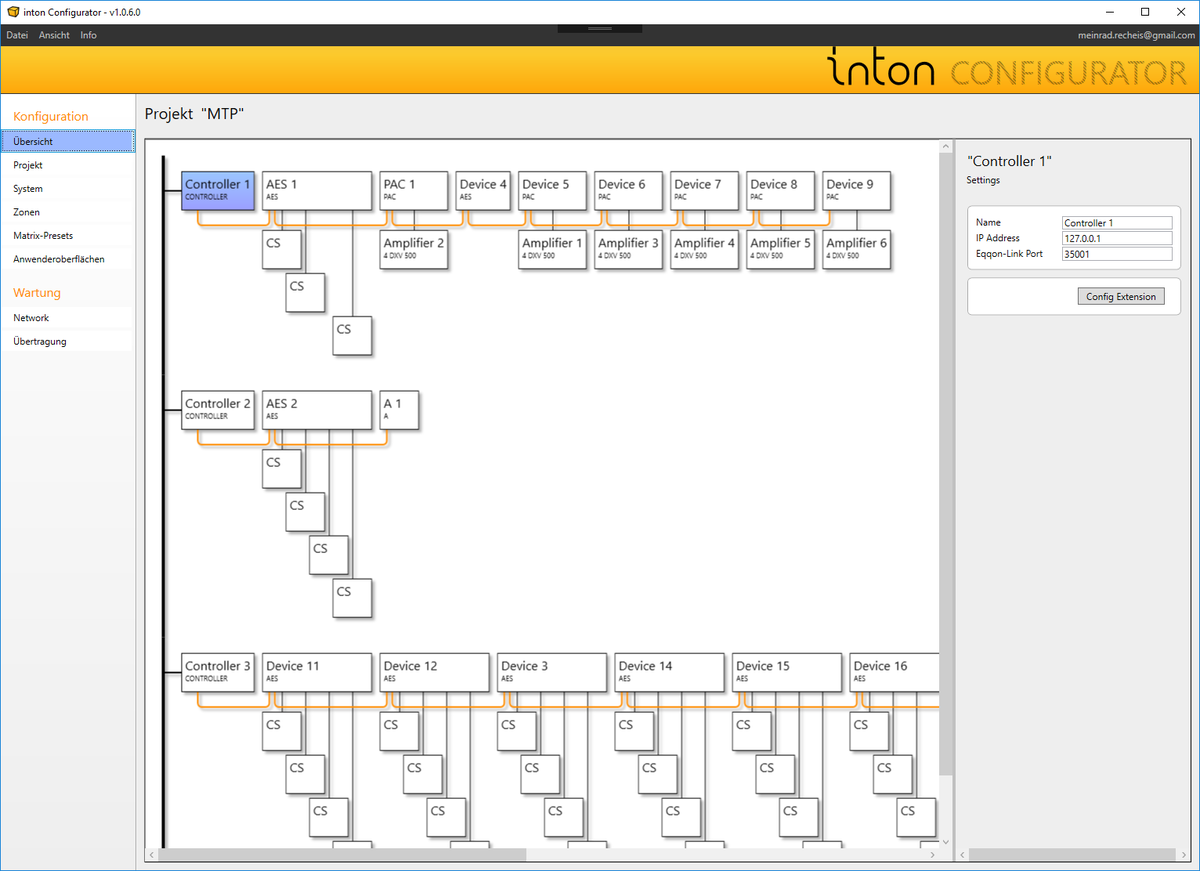
The interactive block diagram provides an overview over the whole project/installation and also functions as a navigation tool to quickly access all settings of every module.
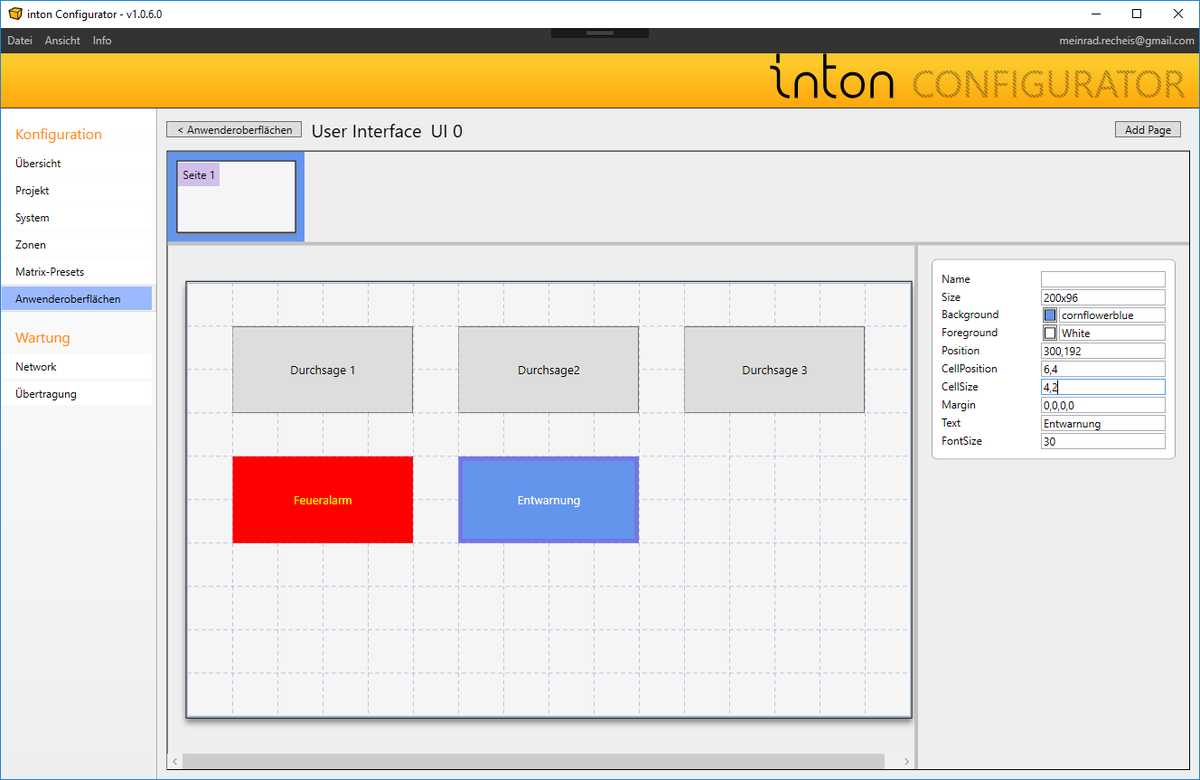
The configuration software contains a GUI designer for touch call stations